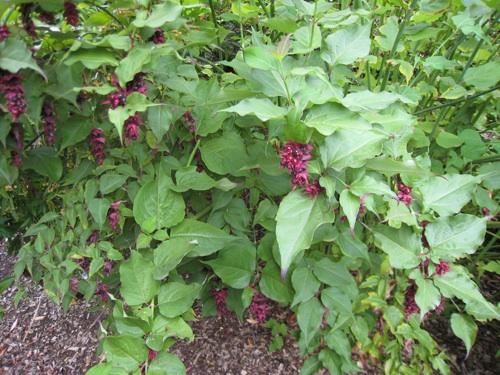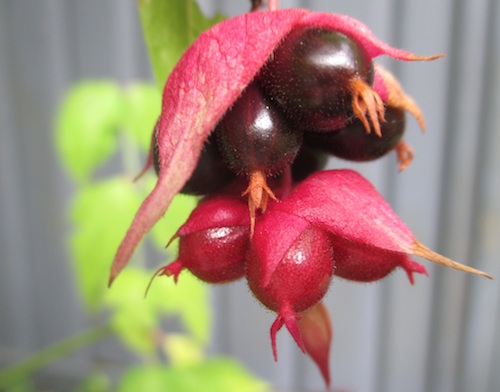
Himalaya Honeysuckle (photo by ALJ)
|

Himalaya Honeysuckle (photo by ALJ)
|
| Himalaya Honeysuckle; Leycesteria formosa Wall. |
Honeysuckle Family; CAPRIFOLIACEÆ
|
| A plant, like a vice president, can be handsome but useless. Good looks alone may be food for the eye, or soul food, but our meaner, more mundane appetites require some grosser substance; on beauty alone we'd starve to death. Should we not have our plants and eat them too? The most useful plants are both beautiful and edible --at the very least fragrant. |
| Himalaya Honeysuckle is a fine example of this. Not rare for lack of merit, it is rare despite its merit. When we eat commercial chocolate we ingest considerable sugar and fat, and pay dearly for it. Himalaya Honeysuckle berries offer chocolate-flavored vitamin pills! |
| Of course, when we think of honeysuckles, visions of fragrant flowering shrubs, coral-colored berries, and climbing vines, all may come to mind. Such honeysuckles are of the genus Lonicera. Three species are native in Seattle and several exotics are commonly grown here. |
| Himalaya Honeysuckle, however, is Leycesteria formosa. William Leycester was a judge in Bengal; formosa refers to its beauty, not to its occurrence on the island of Taiwan. It is also known as Himalaya- or Flowering Nutmeg. Though closely related to Lonicera honeysuckles, it differs in technical details. From northwestern India to southwestern China it grows, one of several species in the genus. Western gardeners have cultivated the shrub since 1824. Though a beautiful thing it is still rare as can be in our area. Why it is so rare is anyone's guess. |
| A few years ago I had never heard of it. A neighbor showed me a strange plant that had sprung up wild in his tomato patch. "What," he inquired, "is this?" I said "Beats me. Why not wait and see? Let it grow." It turned out to be a Himalaya Honeysuckle. Evidently a bird had dropped a seed. Offspring from my neighbor's plant are now reseeding themselves in my garden. |
| The best patch of the plant I know of is in a moist, sunny ravine at the Berkeley Botanic Garden: lush, rank, gorgeous growth thriving in the warmth of California. Locally, our best planting may be at Woodland Park Zoo, south of the Primate House. |
| The plant is a clump-forming shrub of slender, gracefully arching cane-like stems, of the same soothing green color as the very abundant leaves. The overall shape is that of a vase, narrow near the ground and wide-flaring upwards, then dipping down with the branch-ends terminated by dangling flowers and berry clusters. It is essentially evergreen, though winter cold forces some leaves to drop. Indeed, severe Arctic weather kills the tender tips of the canes. Spring, however, witnesses a resurgent burst of sturdy growth, and the plant is soon the picture of robust, elegant beauty! A rare combination! |
| In midsummer it commences to bloom. The creamy-white flowers are attractively backed by burgundy bracts. Deep brown, soft, juicy berries of rich chocolate-caramel flavor ensue. Their season is approximately from late July through early October. |
| In average soil, with little or no watering, Himalaya Honeysuckle grows 4 to 6 feet tall. The addition of a humus mulch and some irrigation brings it to 8 or more feet. It seems to do best with moist roots, and its leaves exposed to much sunshine. However, it will grow in a wide variety of soil and light conditions. Finicky it is not. As far as I've seen it is pest and disease free. |
| If it sounds perfect, it's not. The berries, delicious though they are, ripen a few at a time, which is great for nibbling some daily, but makes the prospect of a fresh, chocolate-flavored pie only a fond dream. The berries, also, are so soft and delicate that they need to be eaten right at their peak of ripeness, lest they shrivel and drop. Another imperfection is that the flowers are inodorous. |
In short, Himalaya Honeysuckle is handsome, easily grown, tasty, and rare enough to be the ideal conversation piece.
|
(Originally published in the November 1989 Seattle Tilth newsletter, along with an illustration by Annie Figliola. Since 1989, Himalaya Honeysuckle has become readily available at local nurseries.)
Back |
|
|

